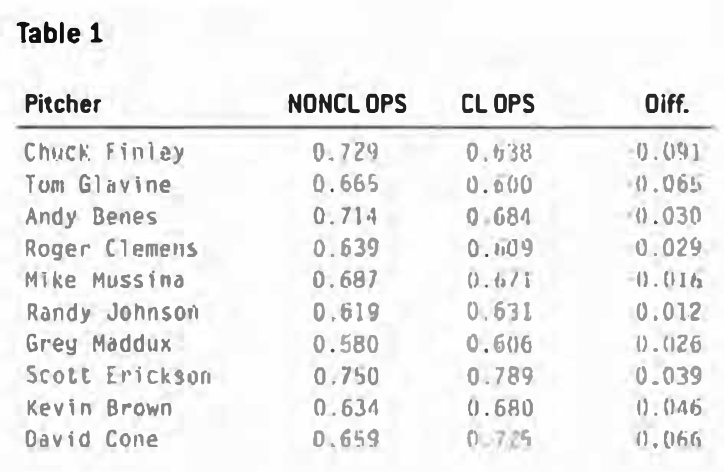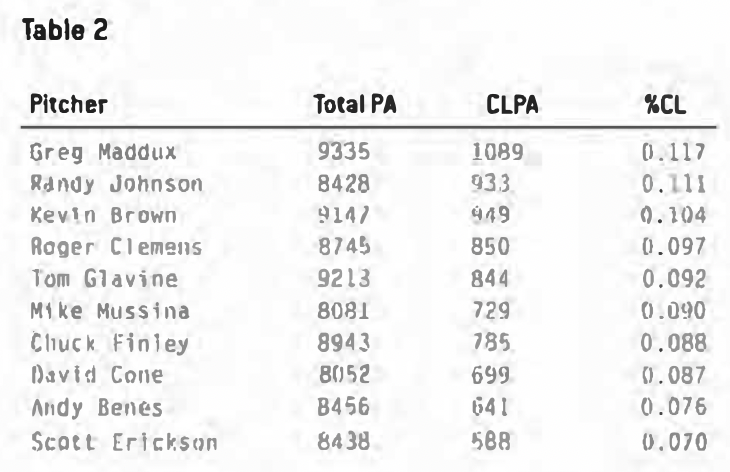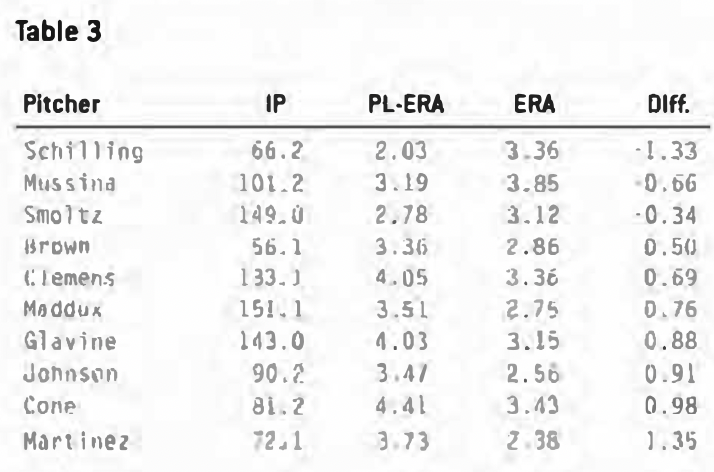Has Greg Maddux Employed the ‘Bagwell Gambit’ in His Career?
This article was written by Cyril Morong
This article was published in 2005 Baseball Research Journal
Leading 8-0 in a regular season game against the Astros, Maddux threw what he had said he would never throw to Jeff Bagwell – a fastball in. Bagwell did what Maddux wanted him to do: he homered. So two weeks later, when Maddux was facing Bagwell in a close game, Bagwell was looking for a fastball in, and Maddux fanned him on a change-up away.
This is what I call the “Bagwell gambit,” allowing a batter to get a hit in a lopsided game to get him looking for a certain pitch in a close game later on (and then get him out on some other pitch). Before looking into the question of whether or not Maddux really makes a habit of doing this, I first examine what happened when Bagwell has homered against Maddux and if it led to a key strikeout in a later game.
Bagwell has hit seven home runs against Maddux. Here they are, in chronological order, with a description of what happened in that game and then their next meeting.
1. May 28, 1995: eighth inning with none on and ATL ahead, 2- 0.This was the only hit Maddux gave up. The final score was 3-1, ATL. NEXT MEETING: June 3, 1995: Maddux struck out Bagwell twice, but Bagwell hits a key home run off Maddux (see home run #2).
2. June 3, 1995: fifth inning with none on and the score tied, 0-0. The final score was 2-1, HOU. NEXT MEETING: July 7, 1996. ATL won, 9-1 (and led 4-0 after three innings). Bagwell struck out once.
3. September 18, 1996: sixth inning with none on and ATL ahead, 6-0. The final score was 6-1, ATL. NEXT MEETING: April 2, 1997. HOU won, 4-3. Bagwell had one hit and struck out once.
4. September 2, 1998: second inning with none on and ATL ahead, 1-0.The final score was 4-2, HOU. NEXT MEETING: June 16, 1999. ATL won, 3-1. Bagwell is 0-4 with two strikeouts against Maddux.
5. August 11, 1999: third inning with one on and ATL ahead, 5- 1. The final score was 8-5, ATL. NEXT MEETING: September 2, 2000. ATL wins, 8-6. Bagwell is 1-3 with one strikeout and one walk against Maddux.
6. May 26, 2004: third inning with one on and HOU ahead, 1-0. The final score was 7-3, HOU. NEXT MEETING: May 31, 2004. CHI wins, 3-1. Bagwell is 1-4 with no strikeouts.
7. April 29, 2005: third inning with none on and CHI ahead, 2-1. The final score was 3-2, CHI. NEXT MEETING: October 2, 2005. Bagwell reached base on a fielder’s choice as a pinch-hitter in his only appearance against Maddux.
There is no case that fits exactly what Will described. The only home run allowed to Bagwell in a lopsided game might have been #3, The other six home runs don’t appear to be ones that Maddux would have intentionally allowed to set up Bagwell for a later date, since the score was close or it was early in the game. Certainly no home run allowed with the score 8-0 followed by a strikeout two weeks later.
In playoff meetings, Bagwell was only 2 for 10 against Maddux. One playoff game was in 1997, when Bagwell went 0-4 with two strikeouts. But Bagwell did not homer off Maddux that year during the regular season. Bagwell was 1-4 in a playoff game on October 5, 1999, that Maddux started. But the Astros beat the Braves, 6-1. Bagwell was 1-2 against Maddux on October 9, 2001, but with no strikeouts. Bagwell did not homer off Maddux during the 2001 regular season.
In general, Bagwell did very well against Maddux with an AVG-OBP-SLG of .309-.367-.593. This compares very favorably to Bagwell’s overall numbers of .297-.408-.541. He has had a better OPS against Maddux (.959) than against all other pitchers (.949). Even using a weighted average, with OBP being considered 50% more important than SLG, Bagwell has done just about as well against Maddux as other pitchers. Multiplying OBP by 1.5 and then adding it to SLG would give Bagwell 1.143 against Madduz and 1.153 against other pitchers. Bagwell struck out just about once in every five ABs in his career while it was once in every 5.67 ABs against Maddux. Per plate appearance Maddux did strike out Bagwell more often than other pitchers. but not by much, once in every 5.73 PAs vs. once in every 5.92 PAs. In general, Maddux has had no dominance over Bagwell. In fact, Bagwell did not homer off him until 1995, four years after he came into the league, covering 36 ABs. This means that Bagwell hit seven home runs against Maddux in his last 45 ABs, quite a high ratio. It seems that Bagwell is figuring out Maddux, not vice-versa.
But what about in general? Has Maddux made a habit of using the “Bagwell gambit” to trick hitters in crucial situations? I looked at how he did in close and late situations (CL) compared to how he did in non-close and late situations over the years 1991-2000 (these are situations when the game is in the seventh inning or later and the batting team is leading by one run, tied, or has the potential tying run on base, at bat or on deck). Since hitters generally don’t do as well in CL as they normally do because they are likely to face relief aces who often have the platoon advantage, it would not be fair to Maddux to judge him based on whether or not he does better in CL than NONCL. So I also looked at how other pitchers fared, in particular, the other nine pitchers in the top ten in innings pitched from 1991 to 2000.
Table 1 shows how these pitchers did when it was close and late and not close and late.
Maddux does worse in CL than NONCL (his OPS increases .026) while some other pitchers actually do better. If Maddux has a pattern of setting up hitters to expect a certain pitch in key situations, it is not evident here, since CL is just the time when he would want to take advantage of the “Bagwell gambit.” In fact, other pitchers seem to improve in CL. That would indicate that they, even more than Maddux, might have been setting up the hitters to look for a certain pitch.
It is possible that Maddux’s OPS in CL is raised by intentional walks, which I have not accounted for here (OBP included only hits, walks, and ABs). But his AVG and SLG also increase, although just 4 and 6 points, respectively. Five pitchers saw their AVG fall and five saw their SLG fall.
In fairness to Maddux, he did face more hitters in CL than these other pitchers. Table 2 shows how many PAs they each had in CL and NONCL and the percentage in CL.
But even so, if Maddux were really setting up the hitters with the “Bagwell gambit,” we would see him do better in CL, if only in comparison to other pitchers.
Another time when we might see the “Bagwell gambit” manifest itself would be in the post-season, particularly the Divisional Series (DS) and League Championship Series (LCS), when Maddux would face hitters he has faced before (in World Series action, he is less likely to have seen the opposing batters before). The hitters in the playoffs are likely to be better than average, so we would expect any pitcher’s ERA to go up then. So I looked at how the top ten pitchers in ERA relative to the league average from 1989 to 2003 (covering the time period in which Maddux appeared in the playoffs) did in DS and LCS games in comparison to their regular season ERAs. Table 3 summarizes this.
PL-ERA is each pitcher’s composite ERA from the DS and LCS. ERA is their composite regular season ERA from years in which they also pitched in the playoffs. Maddux’s performance does not appear to be unusual here. His ERA goes up in the playoffs when facing NL hitters he has faced before. Not a big surprise since these hitters will be better than average. But some pitchers’ ERAs actually go down. In fairness to Maddux, he has pitched the most innings here. But Smoltz has almost as many IP and his ERA actually went down (and Glavine’s performance is very close to Maddux’s). If Maddux was setting up hitters to look for certain pitches, it again does not appear that he was fooling them (at least not any more than he normally fools hitters).
In all, the evidence does not seem to support the idea that Maddux employs the “Bagwell gambit.” If so, we would see unusual improvement in his performance in close and late situations and in NL playoff games. But we do not. Every manager would certainly have loved to have Maddux pitching when it was close and late or in the playoffs. But not because he has the hitters expecting a certain pitch that they hit before. They would have loved to have him because he was a great pitcher in general.
Sources
George Will. “The Artistry of Mr. Maddux,” Newsweek Magazine, April 25, 2005, p. 84.
ESPN website
Yahoo Sports website
Retrosheet website
STATS, Inc. Player Profiles books
Notes
1. In World Series play, Maddux has an ERA of 2.09. But that is against hitters he had less experience facing. His ERAs in the 1995 and 1996 series, before inter-league play began, were 2.25 and 1.72, respectively. He pitched very well against those hitters yet had little opportunity to set them up with the “Bagwell gambit.”





